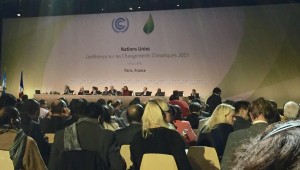Having scored tickets to the Paris Committee’s (see our earlier blog) December 8th meeting, we huddled into the large plenary room at 7pm. Two of our three tickets came from the YOUNGO group and one of our tickets was from the RINGO group. Both organizations are given a limited number of tickets for the plenary events, which they distribute to their constituency members. Even though we could have watched the Committee’s deliberations through teleconferencing in nearby rooms, we felt excited to witness the whole of the vast room, filled with negotiators, academics, simultaneous translators, and students.
At 7.30pm (half an hour after the publicized time of the start of the meeting), dozens of people were still flowing into the room every minute, even though the discussions had already commenced. Just then, one of the Party delegates from India asked to have the floor to remark that while empty seats remained for Party members, they were not being allowed in and being told the room was full. In response, the COP President, Minister Laurent Fabius, reassured the representative that he would have this mistake corrected immediately. Whether or not it was the intervention from the President, by 7.45, there was barely any standing room left in the massive conference hall.
During the event, different facilitators of the Paris Committee reported back on their consultations, which almost always included bilateral negotiations as well as multilateral negotiations. The facilitators lead each of the committee’s work streams in pairs, typically with one representative from a developing country and one from a developed country. During their presentations, many facilitators applauded the common ground found in their negotiations and praised the increased inclusiveness and transparency of the proceedings.
It seemed from this briefing that the 1.5 Celsius language is becoming a real possibility. Yet, the two sticking points — differentiation and loss & damage — continue to divide the Parties. Many of the facilitators emphasized that their negotiations were going to continue that evening, particularly with regard to these two issues. Following the facilitators’ reports, the floor was opened to all Parties. Speaking first, the South African representative expressed the necessity to allow ample time for all Parties and regional groupings to consider the draft of the agreement, which is expected today (Wednesday the 9th) at around 1pm. Her intervention emphasized the position of G77+China that the Paris text should be “Party-owned”. As representatives continued to take the floor, an impressive number of delegates referenced the G77+China. These Parties expressed particular concern with Article 2 of the draft agreement, the section that most explicitly deals with human rights, differentiation, and equity.
As we were leaving the negotiating hall, Al Gore’s impassioned call from his speech earlier in the day rang in our ears — “Our best hope for addressing the climate crisis before it is too late is: Here Now.”
-Anita Desai, Stephen O’Hanlon, Ayse Kaya
Follow us throughout the week on Twitter (@SwarthmoreCOP21) and Snapchat (SwarthmoreCOP21) to get real-time updates.

How exciting that you got to be in the committee room itself! Newspapers are all proclaiming “crunch time”–do you see signs of crunch time around you? How are smaller delegations holding up?
Dear Betsy,
Thanks so much for your comment. It is indeed crunch time. We were witnessing the negotiations until late last night and posted a blog about it this morning – I hope it illuminates how much there is to be done in such a short amount of time.
As for small delegations, there were several mentions of fatigue last night. However, many small delegations expressed gratitude to COP President Fabius for his adapting the structure of further negotiations in an attempt to maximize transparency and access for small delegations.
Keep the questions coming!